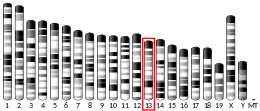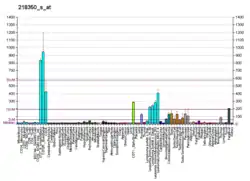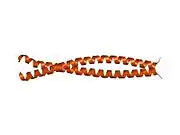Geminin, DNA replication inhibitor, also known as GMNN, is a protein in humans encoded by the GMNN gene.[5] A nuclear protein present in most eukaryotes and highly conserved across species, numerous functions have been elucidated for geminin including roles in metazoan cell cycle, cellular proliferation, cell lineage commitment, and neural differentiation.[6] One example of its function is the inhibition of Cdt1.[7]
History
Geminin was originally identified as an inhibitor of DNA replication and substrate of the anaphase-promoting complex.[8] Coincidentally, geminin was also shown to expand the neural plate in the developing Xenopus embryo.[9]
Structure
Geminin is a nuclear protein made up of about 200 amino acids, with a molecular weight of approximately 25 kDa.[8] It contains an atypical leucine zipper coiled-coil domain. It has no known enzymatic activity nor DNA binding motifs.
Function
Cell cycle control
Geminin is absent during G1 phase and accumulates through S, G2 phase and M phases of the cell cycle. Geminin levels drop at the metaphase-anaphase transition of mitosis when it is degraded by the anaphase-promoting complex.[8]
S phase
During S phase, geminin is a negative regulator of DNA replication. In many cancer cell lines, inhibition of geminin by RNA interference results in re-replication of portions of the genome, which leads to aneuploidy. In these cell lines, geminin knockdown leads to markedly slowed growth and apoptosis within several days.[10] However, the same is not true for primary and immortalized human cell lines, where other mechanisms exists to prevent DNA re-replication.[10] Since geminin knockdown leads to cell death in many cancer cell lines but not primary cell lines, it has been proposed as a potential therapeutic target for cancer treatment.[10]
Mitosis
At the start of the S-phase until late mitosis, geminin inhibits the replication factor Cdt1, preventing the assembly of the pre-replication complex. In early G1, the anaphase promoting complex triggers its destruction through ubiquitination.
Geminin, therefore, is an important player in ensuring that exactly one round of replication occurs during each cell cycle.
Developmental control
Geminin promotes early neural fate commitment by hyperacetylating chromatin.[11] This effect allows neural genes to be accessible for transcription, promoting the expression of these genes. Ultimately, geminin allows cells uncommitted to any particular lineage to acquire neural characteristics.
Geminin has also been shown to interact with the SWI/SNF chromatin remodeling complex.[12] In neural precursor cells, high levels of geminin prevent terminal differentiation. When the interaction between geminin and SWI/SNF is eliminated, geminin's inhibition to this process is eliminated and neural precursors are allowed to differentiate.
Clinical significance
Geminin has been found to be overexpressed in several malignancies and cancer cell lines,[13] while there is data demonstrating that geminin acts as a tumor suppressor by safeguarding genome stability.[14]
References
- 1 2 3 GRCh38: Ensembl release 89: ENSG00000112312 - Ensembl, May 2017
- 1 2 3 GRCm38: Ensembl release 89: ENSMUSG00000006715 - Ensembl, May 2017
- ↑ "Human PubMed Reference:". National Center for Biotechnology Information, U.S. National Library of Medicine.
- ↑ "Mouse PubMed Reference:". National Center for Biotechnology Information, U.S. National Library of Medicine.
- ↑ "Entrez Gene: GMNN geminin, DNA replication inhibitor".
- ↑ Kroll KL (2007). "Geminin in embryonic development: coordinating transcription and the cell cycle during differentiation". Frontiers in Bioscience. 12 (4): 1395–1409. doi:10.2741/2156. PMID 17127390.
- ↑ Alberts, Bruce (18 November 2014). Molecular biology of the cell (Sixth ed.). New York, NY. p. 975. ISBN 978-0-8153-4432-2. OCLC 887605755.
{{cite book}}: CS1 maint: location missing publisher (link) - 1 2 3 McGarry TJ, Kirschner MW (1998). "Geminin, an inhibitor of DNA replication, is degraded during mitosis". Cell. 93 (6): 1043–1053. doi:10.1016/S0092-8674(00)81209-X. PMID 9635433. S2CID 235485.
- ↑ Kroll KL, Salic AN, Evans LM, Kirschner MW (1998). "Geminin, a neuralizing molecule that demarcates the future neural plate at the onset of gastrulation". Development. 125 (16): 3247–3258. doi:10.1242/dev.125.16.3247. PMID 9671596.
- 1 2 3 Zhu W, Depamphilis ML (2009). "Selective killing of cancer cells by suppression of geminin activity". Cancer Research. 69 (11): 4870–4877. doi:10.1158/0008-5472.CAN-08-4559. PMC 2749580. PMID 19487297.
- ↑ Yellajoshyula D, Patterson ES, Elitt MS, Kroll KL (2011). "Geminin promotes neural fate acquisition of embryonic stem cells by maintaining chromatin in an accessible and hyperacetylated state". Proceedings of the National Academy of Sciences USA. 108 (8): 3294–3299. Bibcode:2011PNAS..108.3294Y. doi:10.1073/pnas.1012053108. PMC 3044367. PMID 21300881.
- ↑ Seo S, Herr A, Lim JW, Richardson GA, Richardson H, Kroll KL (2005). "Geminin regulates neuronal differentiation by antagonizing Brg1 activity". Genes & Development. 19 (14): 1723–34. doi:10.1101/gad.1319105. PMC 1176010. PMID 16024661.
- ↑ Montanari M, Boninsegna A, Faraglia B, Coco C, Giordano A, Cittadini A, Sgambato A (2005). "Increased expression of geminin stimulates the growth of mammary epithelial cells and is a frequent event in human tumors". Journal of Cellular Physiology. 202 (1): 215–22. doi:10.1002/jcp.20120. PMID 15389519. S2CID 28652986.
- ↑ Champeris Tsaniras, Spyridon; Villiou, Maria; Giannou, Anastassios D; Nikou, Sofia; Petropoulos, Michalis; Pateras, Ioannis S; Tserou, Paraskevi; Karousi, Foteini; Lalioti, Maria-Eleni (2018-06-27). "Geminin ablation in vivo enhances tumorigenesis through increased genomic instability". Journal of Pathology. 246 (2): 134–140. doi:10.1002/path.5128. ISSN 0022-3417. PMID 29952003. S2CID 49474213.
Further reading
- Maruyama K, Sugano S (1994). "Oligo-capping: a simple method to replace the cap structure of eukaryotic mRNAs with oligoribonucleotides". Gene. 138 (1–2): 171–174. doi:10.1016/0378-1119(94)90802-8. PMID 8125298.
- Suzuki Y, Yoshitomo-Nakagawa K, Maruyama K, Suyama A, Sugano S (1997). "Construction and characterization of a full length-enriched and a 5'-end-enriched cDNA library". Gene. 200 (1–2): 149–156. doi:10.1016/S0378-1119(97)00411-3. PMID 9373149.
- McGarry TJ, Kirschner MW (1998). "Geminin, an inhibitor of DNA replication, is degraded during mitosis". Cell. 93 (6): 1043–1053. doi:10.1016/S0092-8674(00)81209-X. PMID 9635433. S2CID 235485.
- Kroll KL, Salic AN, Evans LM, Kirschner MW (1998). "Geminin, a neuralizing molecule that demarcates the future neural plate at the onset of gastrulation". Development. 125 (16): 3247–3258. doi:10.1242/dev.125.16.3247. PMID 9671596.
- Wohlschlegel JA, Dwyer BT, Dhar SK, Cvetic C, Walter JC, Dutta A (2000). "Inhibition of eukaryotic DNA replication by geminin binding to Cdt1". Science. 290 (5500): 2309–2312. Bibcode:2000Sci...290.2309W. doi:10.1126/science.290.5500.2309. PMID 11125146.
- Bermejo R, Vilaboa N, Calés C (2002). "Regulation of CDC6, geminin, and CDT1 in human cells that undergo polyploidization". Molecular Biology of the Cell. 13 (11): 3989–4000. doi:10.1091/mbc.E02-04-0217. PMC 133609. PMID 12429841.
- Biswas N, Sanchez V, Spector DH (2003). "Human cytomegalovirus infection leads to accumulation of geminin and inhibition of the licensing of cellular DNA replication". Journal of Virology. 77 (4): 2369–2376. doi:10.1128/JVI.77.4.2369-2376.2003. PMC 141111. PMID 12551974.
- Kulartz M, Kreitz S, Hiller E, Damoc EC, Przybylski M, Knippers R (2003). "Expression and phosphorylation of the replication regulator protein geminin". Biochemical and Biophysical Research Communications. 305 (2): 412–420. doi:10.1016/S0006-291X(03)00773-3. PMID 12745091.
- Del Bene F, Tessmar-Raible K, Wittbrodt J (2004). "Direct interaction of geminin and Six3 in eye development". Nature. 427 (6976): 745–749. Bibcode:2004Natur.427..745B. doi:10.1038/nature02292. PMID 14973488. S2CID 4410030.
- Luo L, Yang X, Takihara Y, Knoetgen H, Kessel M (2004). "The cell-cycle regulator geminin inhibits Hox function through direct and polycomb-mediated interactions". Nature. 427 (6976): 749–753. Bibcode:2004Natur.427..749L. doi:10.1038/nature02305. hdl:11858/00-001M-0000-0012-EE32-1. PMID 14973489. S2CID 8020382.
- Sugimoto N, Tatsumi Y, Tsurumi T, Matsukage A, Kiyono T, Nishitani H, Fujita M (2004). "Cdt1 phosphorylation by cyclin A-dependent kinases negatively regulates its function without affecting geminin binding". Journal of Biological Chemistry. 279 (19): 19691–19697. doi:10.1074/jbc.M313175200. PMID 14993212.
- Melixetian M, Ballabeni A, Masiero L, Gasparini P, Zamponi R, Bartek J, Lukas J, Helin K (2004). "Loss of Geminin induces rereplication in the presence of functional p53". Journal of Cell Biology. 165 (4): 473–482. doi:10.1083/jcb.200403106. PMC 2172361. PMID 15159417.
- Ramachandran N, Hainsworth E, Bhullar B, Eisenstein S, Rosen B, Lau AY, Walter JC, LaBaer J (2004). "Self-assembling protein microarrays". Science. 305 (5680): 86–90. Bibcode:2004Sci...305...86R. doi:10.1126/science.1097639. PMID 15232106. S2CID 20936301.
- Ballabeni A, Melixetian M, Zamponi R, Masiero L, Marinoni F, Helin K (2004). "Human geminin promotes pre-RC formation and DNA replication by stabilizing CDT1 in mitosis". EMBO Journal. 23 (15): 3122–3132. doi:10.1038/sj.emboj.7600314. PMC 514931. PMID 15257290.
- Saxena S, Yuan P, Dhar SK, Senga T, Takeda D, Robinson H, Kornbluth S, Swaminathan K, Dutta A (2004). "A dimerized coiled-coil domain and an adjoining part of geminin interact with two sites on Cdt1 for replication inhibition". Mol. Cell. 15 (2): 245–258. doi:10.1016/j.molcel.2004.06.045. PMID 15260975.
- Zhu W, Chen Y, Dutta A (2004). "Rereplication by depletion of geminin is seen regardless of p53 status and activates a G2/M checkpoint". Molecular and Cellular Biology. 24 (16): 7140–7150. doi:10.1128/MCB.24.16.7140-7150.2004. PMC 479725. PMID 15282313.
- Kulartz M, Knippers R (2004). "The replicative regulator protein geminin on chromatin in the HeLa cell cycle". Journal of Biological Chemistry. 279 (40): 41686–41694. doi:10.1074/jbc.M405798200. PMID 15284237.
External links
- GMNN+protein,+human at the U.S. National Library of Medicine Medical Subject Headings (MeSH)
- Overview of all the structural information available in the PDB for UniProt: O75496 (Human Geminin) at the PDBe-KB.
- Overview of all the structural information available in the PDB for UniProt: O88513 (Mouse Geminin) at the PDBe-KB.







